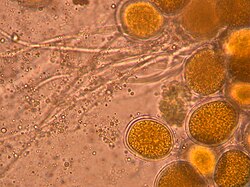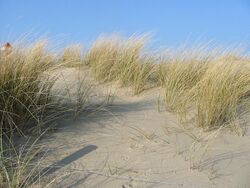Biology:Endogone
| Endogone | |
|---|---|

| |
| A sporocarp of Endogone pisiformis | |

| |
| Double-walled zygospores of E. pisiformis | |
| Scientific classification | |
| Kingdom: | |
| Division: | |
| Subdivision: | |
| Order: | |
| Family: | Endogonaceae
|
| Genus: | Endogone Link (1809)
|
| Type species | |
| Endogone pisiformis Link (1809)
| |
| Species | |
|
~25, see text | |
Endogone is a genus of fungi in the family Endogonaceae of the division Zygomycota. The genus has a widespread distribution, especially in temperate regions, and contains about 20 species.[1]
Species of Endogone form underground structures called sporocarps—fruiting structures measuring between a few millimeters to 2–3 cm (0.8–1.2 in) in diameter, containing densely interwoven hyphae and zygospores. Sporocarps are typically found in humus-rich soil or leaf mold, or in mosses.[2] Although most species will only produce spores in nature, the type species E. pisiformis can be made to sporulate in test tube culture when grown with conifer seedlings.[3]
Taxonomy
Endogone was first circumscribed by Johann Heinrich Friedrich Link in an 1809 publication.[4] In 1922, Roland Thaxter revised the taxonomy of the family Endogonaceae, recognizing four genera: Endogone, Sphaerocreas, Sclerocystis, and Glaziella.[5] In 1935, Herbert Zycha transferred the sole species of Sphaerocreas recognized by Thaxter to Endogone. In their 1974 monograph of the Endogonaceae, James Gerdemann and James Trappe deviated from Thaxter’s concept of Endogone, which contained taxa with chlamydospores and zygospores, including only those species that formed zygospores in sporocarps. In the mid-1990s, Yi-Jian Yao and colleagues further restricted Endogone to those species that produced suspensors that were in contact with one another along the entire length. Those taxa in which the suspensors did not touch one another were transferred to a new genus, Youngiomyces.[6][7]
The generic name is derived from the Greek words endo (inside) and gone (reproductive organs).[8]
Description
Endogone species are sporocarpic—they form a fruit body termed a sporocarp, on which spore-bearing structures are borne. The zygospores—a diploid reproductive stage in the life cycle—are formed above the point of union of two gametangia, or from a budding from the larger of the two.[8] Species in the genus can be saprobic, ectomycorrhizal, or both.
Ecology
Depending on the species, sporocarps have been noted to have the odor of onions, burnt sugar, or fish.[9] Endogone grows in soil, on rotting wood, sphagnum or other plant material either as saprobes or ectomycorrhizal associates.[10] Endogone is especially important in the ecology of nutrient-poor soils. For example, Endogone fungi are known to grow in sand dunes, a nutrient-deficient substrate. Dune plants are dependent upon the fungus for growth and ecological success: the mycelium of the fungus helps aggregate and stabilize the sand in a network of hyphae, giving it cohesion and helping early succession plants establish roots. It also traps and binds fragments of organic material such as decaying roots and rhizomes.[11]
Various species of rodents and shrews include Endogone fungi in their diets, including the southeastern shrew (Sorex longirostris),[12] the masked shrew (Sorex cinereus),[13] the vagrant shrew (Sorex vagrans),[14] the woodland jumping mouse (Napaeozapus insignis),[15] the Siskiyou chipmunk (Tamias siskiyou),[16] and the marsh rice rat (Oryzomys palustris).[17]
Species
- E. acrogena Gerd., Trappe & Hosford 1974
- E. aggregata P.A.Tandy 1975 – Australia[18]
- E. alba (Petch) Gerd. & Trappe 1974
- E. arenaria Thaxt. 1922[5]
- E. aurantiaca Blaszk. 1997[19]
- E. crassa P.A.Tandy 1975 – Australia[18]
- E. flammicorona Trappe & Gerd. 1972
- E. incrassata Thaxt. 1922[5]
- E. irregularis Szem. 1965
- E. kaiseriana Henn. 1908
- E. lactiflua Berk. 1846
- E. lanata Harkn. 1899
- E. maritima Blaszk., Tadych & Madej 1998[20]
- E. minutissima Beeli 1924 – Europe[21]
- E. oregonensis Gerd. & Trappe 1974
- E. pegleri Y.J.Yao 1995[6]
- E. pisiformis Link 1809[4]
- E. pseudopisiformis Y.J.Yao 1995[6]
- E. reticulata P.A.Tandy 1975 – Australia[18]
- E. rosea Zeller 1941
- E. sphagnophila G.F.Atk. 1918
- E. tjibodensis Boedijn 1935
- E. torrendii Bres. 1920
- E. tuberculosa Lloyd 1918[22]
- E. verrucosa Gerd. & Trappe 1974
- E. xylogena J.Schröt. 1887
References
- ↑ Dictionary of the Fungi (10th ed.). Wallingford, UK: CAB International. 2008. p. 233. ISBN 978-0-85199-826-8.
- ↑ "Endogone: food for mice". Journal of Mammalogy 45 (2): 265–271. 1964. doi:10.2307/1376990.
- ↑ "Sporulation of Endogone pisiformis in axenic and monaxenic culture". Mycologia 78 (2): 292–295. 1986. doi:10.2307/3793176. http://www.cybertruffle.org.uk/cyberliber/59350/0078/002/0292.htm.
- ↑ 4.0 4.1 Link HF. (1809). "Observationes in ordines plantarum naturales. Dissertatio I". Magazin der Gesellschaft Naturforschenden Freunde Berlin 3: 3–42.
- ↑ 5.0 5.1 5.2 Thaxter R. (1922). "A revision of the Endogonaceae". Proceedings of the American Academy of Arts and Sciences 57 (12): 291–351. doi:10.2307/20025921. https://www.biodiversitylibrary.org/page/3092650.
- ↑ 6.0 6.1 6.2 "New species in Endogone (Endogonales)". Kew Bulletin 50 (2): 359–365. 1995. doi:10.2307/4110642.
- ↑ Genera of Endogonales. Kew, UK: Royal Botanic Gardens. 1996. ISBN 978-0947643928.
- ↑ 8.0 8.1 Gerdemann & Trappe, 1974, p. 8.
- ↑ Gerdemann & Trappe, 1974, pp. 11–19.
- ↑ Warcup JH. (1990). "Taxonomy, culture, and mycorrhizal associations of some zygosporic Endogonaceae". Mycological Research 94 (2): 173–178. doi:10.1016/S0953-7562(09)80609-6.
- ↑ "Ecology of Endogone in Lake Huron sand dunes". Canadian Journal of Botany 53 (2): 87–93. 1975. doi:10.1139/b75-014.
- ↑ "Diet of the southeastern shrew (Sorex longirostris) in Tennessee". Journal of the Tennessee Academy of Science 75 (1–2): 42–43. 2000. ISSN 0040-313X.
- ↑ Hamilton WJ. (2004). "Sorex cinereus". Mammalian Species 743: 1–9. doi:10.1644/1545-1410(2004)743<0001:sc>2.0.co;2. http://www.science.smith.edu/msi/pdf/743_Sorex_cinereus.pdf. Retrieved 2012-09-03.
- ↑ "Sorex vagrans". Mammalian Species 744: 1–5. 2004. doi:10.1644/1545-1410(2004)744<0001:sv>2.0.co;2. http://www.science.smith.edu/msi/pdf/744_Sorex_vagrans.pdf.
- ↑ "Does fungus consumption by the woodland jumping mouse vary with habitat type or the abundance of other small mammals?". Canadian Journal of Zoology 81 (4): 753–756. 2003. doi:10.1139/Z03-035.
- ↑ McIntyre PW. (1984). "Fungus consumption by the Siskiyou chipmunk within a variously treated forest". Ecology 65 (1): 137–146. doi:10.2307/1939466.
- ↑ Mammals of the eastern United States. Cornell University Press. 1998. p. 280. ISBN 0-8014-3475-0. https://archive.org/details/mammalsofeastern00whit/page/280.
- ↑ 18.0 18.1 18.2 Tandy PA. (1975). "Sporacarpic species of Endogonaceae in Australia". Australian Journal of Botany 23 (5): 849–866. doi:10.1071/bt9750849.
- ↑ Baszkowski J. (1997). "Endogone aurantiaca, a new species in the Endogonales from Poland". Mycotaxon 63: 131–141. http://www.cybertruffle.org.uk/cyberliber/59575/0063/0131.htm.
- ↑ "Endogone maritima, a new species in the Endogonales from Poland". Mycological Research 102 (9): 1096–1100. 1998. doi:10.1017/S0953756298006170.
- ↑ Beeli M. (1923). "Notes mycologiques. Champignons nouveaux pour la flore Belge, récoltés de 1915 à 1923" (in fr). Bulletin de la Société Royale de Botanique de Belgique 56: 57–68.
- ↑ Lloyd CG. (1918). "Mycological Notes 56". Mycological Writings 5 (56): 797–812.
Cited literature
- "The Endogonaceae in the Pacific Northwest". Mycologia Memoirs (New York Botanical Garden) 5. 1974.
Wikidata ☰ Q5376344 entry
 |


